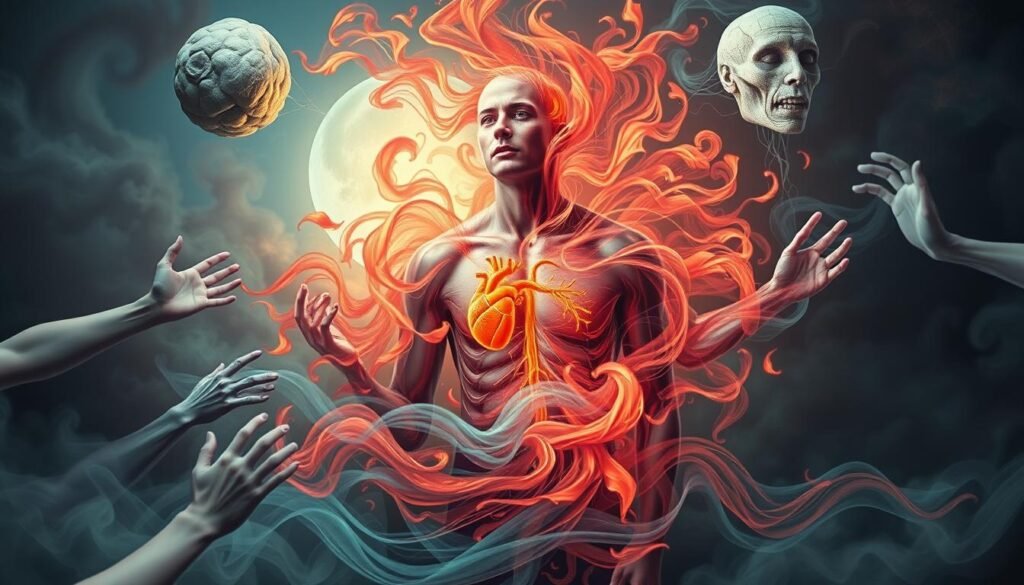Nearly half of all doctor visits in the U.S. are for concerns often linked to anxiety. Issues like fatigue, dizziness, and headaches point to anxiety’s physical side. These effects are very real, even if not always recognized by medical books. Millions feel these physical signs of their mental strain.
It’s important to understand how anxiety can show up physically. Signs vary from muscle tightness and pains to stomach problems and shortness of breath. Knowing these symptoms enables focused ways to improve life for those fighting anxiety.
Key Takeaways
- Somatic anxiety reflects the physical presentation of psychological distress.
- A significant portion of primary care visits relates to symptoms typical of anxiety.
- Recognizing somatic symptoms is vital for effective management strategies.
- Common physical manifestations include muscle tension, gastrointestinal issues, and dizziness.
- Awareness and understanding can lead to improved coping mechanisms.
Introduction to Somatic Anxiety
Somatic anxiety is when mental stress shows up as physical problems. It shows that deep emotional issues can turn into physical experiences. It’s hard for people to tell if these are mental or physical issues. “Somatic” means these feelings are real in the body, not just in the mind.
Somatic anxiety disorder turns mental stress into physical symptoms. It’s different from conditions listed in the DSM-5-TR. Many people experience this disorder. It activates the “fight or flight” response. This response can cause pain, tiredness, and stomach issues. This shows the strong link between mind and body in anxiety disorders.
Anxiety’s physical symptoms can disrupt someone’s daily life. This creates a loop of seeking relief from physical pain while dealing with mental issues. Understanding this link helps in treating both the body and the mind.
Understanding the Fight or Flight Response
The fight or flight response kicks in during anxiety, preparing us for quick action. It’s a reflex that helps us deal with threats. Our bodies undergo changes that can impact our health.
Physiological Changes Triggered by Anxiety
When we get anxious, our body releases stress hormones like adrenaline and cortisol. These hormones cause:
- Increased heart rate
- Rapid breathing
- Dilated pupils
- Elevated muscle tension
- Altered digestive functions
This makes us ready to face or escape danger. But, this reaction can last up to 60 minutes after the danger is gone. Staying in this state too long can lead to anxiety disorders and harm our immune system.
The Role of Stress Hormones
Stress hormones play a big role in how we experience anxiety and stress. Long-term fight-or-flight activation increases the risk of anxiety disorders. People under constant stress have high adrenaline levels. This keeps them tense and alert. Learning how to manage stress can help in handling these reactions better. For more information, visit this detailed discussion.
Common Physical Manifestations of Anxiety
Anxiety can show up through different physical signs that disrupt everyday life. It’s important to know about these physical symptoms of anxiety. By understanding them, people can recognize their effects and see when they might need help.
Muscle Tension and Aches
Muscle tension is a common sign of anxiety, especially in the shoulders, neck, and back. Stress makes muscles tighten, causing pain and chronic aches. This tension can make it hard to move and affect a person’s well-being, limiting what they can do each day.
Gastrointestinal Disturbances
Gastrointestinal issues often occur with anxiety, such as stomachaches, nausea, and bloating. These symptoms can mess with someone’s digestion. The connection between the gut and brain is important. Anxiety can upset the stomach, leading to uncomfortable symptoms.
Respiratory Symptoms
Respiratory issues are also linked to anxiety. People may feel short of breath or breathe rapidly when stressed. These symptoms can make anxiety worse and create a vicious cycle. This makes it hard for individuals to do physically demanding activities.
Somatic Symptoms of Anxiety: Identifying Warning Signs
It’s vital to spot the warning signs of anxiety early. This helps in getting help sooner. Somatic symptoms are physical and they greatly affect a person’s life. Catching these signs early means you can talk to doctors sooner.
Some common somatic symptoms include:
- Persistent discomfort or pain
- Chronic fatigue
- Changes in appetite or weight
- Frequent headaches or gastrointestinal issues
About 5%-7% of adults face somatic symptom disorder. It’s more common in women, who are ten times as likely as men to get it. Symptoms often start by age 30. Knowing these symptoms helps in managing them better.
Those with this disorder face many issues. These include trouble in relationships and at work. They might also have depression and anxiety. This can make somatic symptoms worse. Knowing the warning signs of anxiety is key to taking control of your health.
Looking for more data on physical symptoms and anxiety? Check out the Mayo Clinic for great info.
Being aware of somatic symptoms and catching them early helps. It lessens the problems they cause. This leads to a healthier, happier life.
| Symptom | Description |
|---|---|
| Pain | Most prevalent symptom that may not have a clear medical cause. |
| Fatigue | Consistent tiredness or lack of energy affecting daily activities. |
| Gastrointestinal Issues | Symptoms may include bloating, constipation, or diarrhea. |
| Headaches | Frequent occurrences that may not respond to typical treatments. |
The Impact of Somatic Symptoms on Daily Life
Somatic symptoms have a big impact on how anxiety affects someone’s daily life. These symptoms can make it hard to work and maintain personal relationships. Understanding their impact is key to tackling the problems anxiety brings.
Challenges in Professional Settings
At work, somatic symptoms can cause problems. People might find it hard to focus, leading to less work done. A study shows that 45.4% of health workers report anxiety symptoms, and 22.9% of them also have physical signs. This leads to more days off work and a drop in team spirit and morale.
Sociability and Relationships Affected by Anxiety
Anxiety can make it tough to be social due to physical symptoms. People with anxiety might avoid social events to not feel embarrassed. This can make them feel isolated as they see less of friends and family. It’s important to understand how anxiety affects relationships and offer support to those affected.
Psychosomatic Symptoms of Anxiety: A Deeper Dive
Anxiety can show up in more than just our thoughts and feelings. It’s important to understand that our mind and body are linked. This link explains how anxiety can affect our daily lives. Knowing about these effects can help in finding the right treatment.
Understanding the Mind-Body Connection
Our mental state can impact our physical health. Anxiety can cause symptoms like tense muscles, stomach problems, and tiredness. Our body reacts to stress as if it’s a real danger, causing real discomfort. Recognizing this link is key in treating conditions often mistaken for something else.
Common Misdiagnoses in Primary Care
Doctors sometimes misdiagnose anxiety because they focus on physical symptoms. This mistake can lead to the wrong treatment. For example, treating someone for heart issues when they’re actually experiencing anxiety. Understanding anxiety’s physical signs leads to better care for patients.

| Physical Symptoms | Common Misdiagnoses | Potential Underlying Causes |
|---|---|---|
| Chest Pain | Cardiovascular Disease | Anxiety |
| Dizziness | Vestibular Disorders | Stress or Anxiety |
| Gastrointestinal Issues | IBS or Food Intolerance | Panic or Generalized Anxiety |
| Muscle Tension | Musculoskeletal Disorders | Stress-related Muscle Tightness |
| Fatigue | Chronic Fatigue Syndrome | Ongoing Anxiety or Stress |
Understanding the mind-body link helps in treating anxiety in a complete way. It helps healthcare providers see beyond the physical symptoms. This leads to better treatment for patients’ overall health.
Managing Physical Anxiety Symptoms
Learning how to manage physical anxiety symptoms can greatly boost your well-being. Self-care is key to dealing with these symptoms, giving you power over your feelings. Using mindfulness can also help you stay calm and cope better.
Self-Care Techniques for Somatic Anxiety
It’s important to use self-care to handle anxiety’s physical signs. Here are some effective ways:
- Yoga: Yoga relaxes you and eases body tension, especially where it’s common like in your back, neck, and shoulders.
- Mindfulness meditation: This practice lowers your anxiety by making you focus on now, reducing worry and fear.
- Physical exercise: Working out boosts your mood, cuts down stress, and adds energy. It’s good for stopping panic attacks.
- Nutrition: Eating well, avoiding caffeine and sugar, can make anxiety milder and stop symptoms from getting worse.
Alternative Therapies and Mindfulness Practices
Along with usual self-care, trying different therapies may offer extra help. Some good options include:
- Acupuncture: This can ease the physical pain linked with anxiety by affecting the nervous system.
- Aromatherapy: Essential oils are good for lessening anxiety and making you relax.
- Guided imagery: Visualizing peaceful scenes can calm your mind and help manage bodily feelings of anxiety.
Medications for Somatic Anxiety Symptoms
Many people use medications for anxiety to help with somatic anxiety symptoms. There are drugs designed to ease both the mind and body aspects of anxiety. Knowing about the different medication types helps people choose what’s best for their health.
Types of Medications Available
A variety of anxiety treatment options are available to ease somatic symptoms. Here are the main types:
- Selective Serotonin Reuptake Inhibitors (SSRIs): These, like fluoxetine and sertraline, manage serotonin levels to lower anxiety.
- Serotonin-Norepinephrine Reuptake Inhibitors (SNRIs): Drugs such as venlafaxine deal with both serotonin and norepinephrine to help control anxiety and its physical effects.
- Beta-blockers: These are useful for physical issues like fast heartbeat or shaking, especially in certain anxiety events.
- Benzodiazepines: Good for quick relief of intense anxiety, but it’s best not to use them for a long time because of addiction risks.
Antidepressants combined with therapies like cognitive-behavioral therapy are very effective against somatic anxiety. Health professionals should keep a close watch to give the best personal care based on one’s symptoms.
When to Seek Professional Help
It’s important to know when to get professional help for anxiety. If somatic symptoms don’t get better and affect your everyday life, see a healthcare provider. Look out for:
- Symptoms that lifestyle changes or non-prescription medicines can’t help.
- Getting more physical symptoms like pain or tiredness that don’t have a medical reason.
- If your condition starts to hurt your social life, job, or personal tasks.
If you go for a medical check-up, you might get referred for therapy. This makes for a well-rounded approach to tackle somatic anxiety. Good communication with your doctor means better, coordinated care and results.

Anxiety-Related Bodily Sensations and Their Implications
Anxiety shows up in many ways, often through how we feel physically. These feelings, like headaches or ongoing pain, might not seem important but they are. They come from anxiety. Knowing these signs helps us handle both mental and body health.
Recognizing Bodily Expressions of Anxiety
Understanding how anxiety appears in our bodies is key. We might feel:
- Tightness in the chest
- Increased heart rate
- Fatigue without clear cause
- Chronic pain in muscles or joints
This can make us feel really uncomfortable. It can also make our anxiety worse. Knowing these signs helps us get help and feel better.
The Interconnection of Anxiety and Chronic Pain
Studies show that chronic pain and anxiety are often linked. People with chronic pain might also be dealing with anxiety. This link means our mental health affects how our body feels.
Those with chronic pain might feel more anxious. People with anxiety might feel worse physically. It’s important to treat both to feel better.
| Condition | Common Symptoms | Potential Treatment Approaches |
|---|---|---|
| Anxiety Disorders | Muscle tension, fatigue, panic attacks | Cognitive Behavioral Therapy, medication, mindfulness |
| Chronic Pain | Persistent aches, reduced mobility, fatigue | Physical therapy, medication, lifestyle changes |
| Interrelation | Exacerbated symptoms, cyclical discomfort | Integrated treatment for both anxiety and chronic pain |
Strategies for Coping with Somatic Anxiety Complaints
Coping with somatic anxiety involves several steps. It’s about easing physical symptoms and making you feel better overall. Techniques like breathing and relaxation are very important. Regular exercises also play a big part in improving both mental and physical health for anyone facing anxiety.
Breathe and Relaxation Techniques
Adding relaxation techniques to your day can greatly affect somatic anxiety management. Breathing exercises, such as diaphragmatic breathing, are a big help. They calm your nervous system and lessen anxiety symptoms. These practices make you concentrate on your breath, leading to peace.
- Deep breathing: Inhale deeply through the nose, hold for a few seconds, and exhale slowly through the mouth.
- Progressive muscle relaxation: Tense and then relax each muscle group in succession, starting from the toes and working up to the head.
- Guided imagery: Visualize a calm and peaceful scene to encourage relaxation.
These methods are good for coping with somatic anxiety and reducing chronic stress.
The Importance of Physical Activity
Regular physical activity is key for those with anxiety. It boosts your mood naturally with endorphins. Walking, jogging, yoga, or swimming are all great. They cut down anxiety symptoms and boost your mood. Plus, regular exercise helps with:
- Improved sleep, often disrupted by anxiety.
- Higher energy during the day.
- Better social connections, especially in groups.
An enjoyable exercise can be a fun way to lessen stress and enhance well-being. Realizing how connected our bodies and minds are helps us use these strategies better.
Recognizing psychological distress underlying somatic complaints is key for better coping. By using these methods and understanding their effects, your quality of life can improve significanltly.

The Role of Psychotherapy in Treating Somatic Anxiety
Psychotherapy is key in managing somatic anxiety. Physical symptoms often come with anxiety disorders. It’s vital to recognize and address these signs. Through psychotherapy, people can explore what causes their somatic feelings.
Cognitive Behavioral Therapy Benefits
Cognitive Behavioral Therapy (CBT) is effective for somatic symptoms. It helps identify and challenge negative thoughts. This leads to better emotional and physical health. A large number of patients find relief from symptoms with CBT. It’s widely used for somatization disorders and includes:
- Reframing cognitive distortions
- Learning coping strategies
- Implementing relaxation techniques
Patients with chronic diseases may face anxiety or depression. Psychotherapy helps them see their situation in a new light. This can lessen their burden.
Integrative Approaches to Mental Health
Integrative mental health combines multiple therapy methods. This boosts overall treatment effectiveness. It’s especially good for those with disorders like hypochondria. It takes care of both mental and physical health.
Including mindfulness and reflection improves emotional awareness. It helps in managing symptoms. Psychotherapy provides vital support for dealing with anxiety and physical feelings. It leads to healing. Understanding these connections helps people seek help early. This resource shows a more complete and effective health approach.
Conclusion
Knowing the physical signs of anxiety is key. It helps us understand how anxiety affects our health. Symptoms like heart racing, chest pain, and stomach issues are clues. They show that anxiety might be the root cause, pushing us to look after both our mind and body.
An overview of somatic anxiety shows how our minds and bodies are linked. It warns us about the dangers of ignoring these signs. Research shows some of these symptoms could point to bigger health problems, like heart disease. This means we need to pay more attention to the different ways anxiety shows up.
By learning to manage anxiety through self-care and expert help, we can get better. We need to encourage each other to notice the signs and be proactive.
Taking steps to understand and tackle these symptoms does more than boost our mental toughness. It improves how we function every day, giving us back control over our lives.